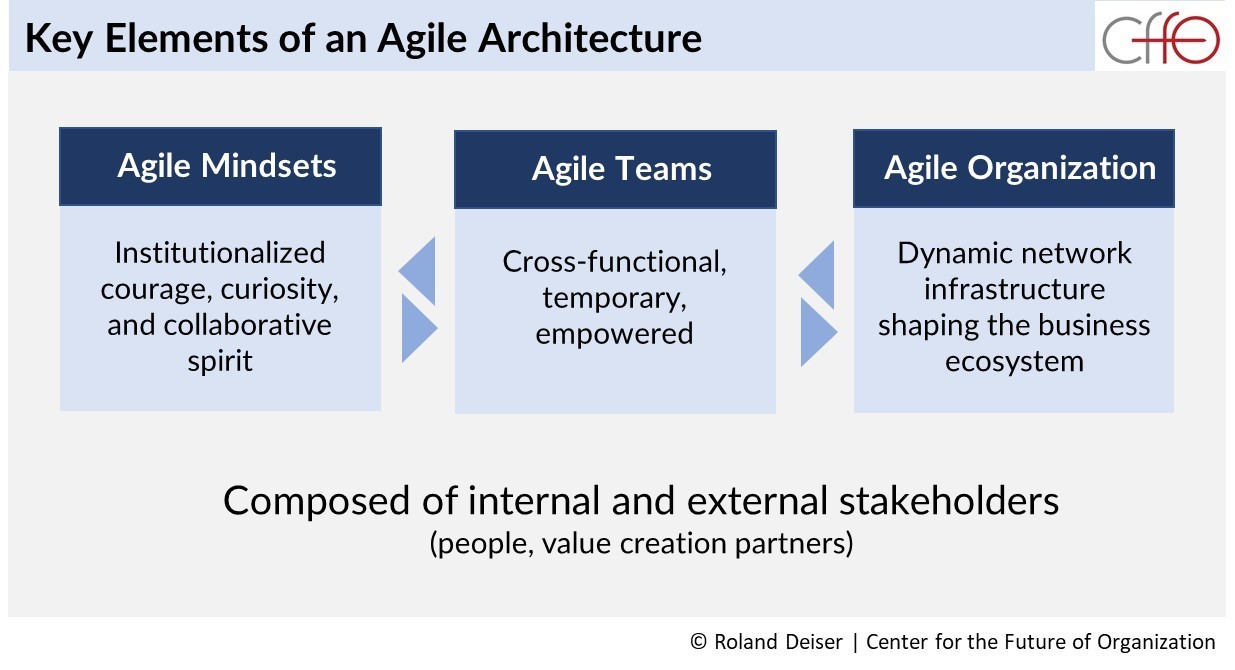Virtually all the executives we spoke during our investigation on Digital Transformation Challenges agreed on the importance of overcoming the pervasive silo culture and inward orientation that most large organizations are suffering from.
Working across boundaries – no matter if they are boundaries of mind, function, division, or organization – is a key ingredient of transformational learning. Rather than fighting for one’s own perspective, leaders must leverage the dynamics resulting from the difference that constitutes boundaries.
Embracing unavoidable friction as an opportunity to learn and create something new is a key success factor not only for developing ideas and engage in new ways of work; it is also essential for reshaping the very essence of the structural and cultural set-up of an organization.
Rather than fighting for one’s own perspective, leaders must leverage the dynamics resulting from the difference that constitutes boundaries.
In this context, it is important to distinguish three dimensions of agility:
- Agile mindsets – which relates to fostering courage, curiosity, and a collaborative spirit as key elements of individual capabilities. People who have no guts, no curiosity, and who have a hard time to collaborate won’t function well in agile teams, and they will be a barrier to any team’s success. Companies address this domain usually by offering workshops in agile methods, such as design-thinking, scrum, hackathons, and more.
- Agile teams – which relates to aggregating people from various functions in a dedicated team and providing them with a high degree of autonomy, thus circumventing the traditional organizational structure. Through their cross-functional composition and their freedom from corporate constraints, they bring all ingredients to the table that are needed for creative new solutions. The agile team design also short-cuts the path to implementation in contrast to the more traditional linear process which is slow and often runs into ‘not invented here’ resistance when a proposal moves from one functional department to the next. Agile teams are typically temporary and dissolve after they have successfully completed their mission.
- Agile organization – which relates to the way a company structures its collaboration with stakeholders of the business ecosystem of an organization (customers, suppliers, regulators, competitors, strategic alliances, industry associations, start-ups, etc.). This dimension includes engaging in co-creation efforts, designing open innovation architectures, participating in multi-stakeholder platforms, etc.
Together, these three dimensions form a self-reinforcing agile architecture which is instrumental for digital transformation to succeed. Limiting agility efforts to only one dimension won’t work.
the ability to drive and orchestrate an inter-organizational network has become a critical success factor in the digital world
People with agile mindsets that remain trapped in traditional structures, without the opportunity to apply their creativity and collaborative spirit in agile teams, will either fall back into old routines or leave the company to work in more accommodating environments. Equally, agile teams that are composed of people without an agile mindset won’t be very effective.
And if agility does not become organizational in terms of re-configuring a company’s collaboration patterns with the relevant environment, organizations will remain introverted, missing out on the critical inputs from the marketplace, and they won’t have much strategic impact on the changing industry. After all, the ability to drive and orchestrate an inter-organizational network has become a critical success factor in the digital world.
The chart below illustrates the interplay of the three dimensions. Please note that the players that constitute an agile architecture are both people and (micro)organizations, and they include internal and external stakeholders who shape the business ecosystem of the corporation through the way they collaborate across boundaries.
Activities to develop agility proliferate in today’s organizations that strive for digital maturity – especially in the domains of agile mindset and agile team efforts. In many cases these initiatives happen uncoordinated, creating multiple pockets of experimentation. People are using different processes in different locations which all may work – but the organization becomes fragmented, and it is increasingly difficult for senior management to gain a holistic, overall perspective of operations.
We rarely see a C-level function which is clearly in charge of driving and orchestrating an integrated agility architecture that addresses all three domains and assures their productive interplay. We will come back to this topic when we take a closer look at the role of the Chief Digital Officer in a later installment of this series.
This article is the fourth part of a LinkedIn series about Digital Transformation Challenges in Large and Complex Organizations. It is based on a qualitative study conducted by the Center for the Future of Organization at the Drucker School of Management at Claremont Graduate University.
If you would like to get immediate access to the entire analysis of our findings, you may download an electronic copy of the report at no cost here, or get it as a physical booklet here. In return, we’d love to learn about your perspective – feel free to comment and/or share your experience with the subject. Thank you!
Other articles in this series
- Digital Transformation Challenges – Part 1: Introduction and Overview
- Part 2: Is Digital Transformation really so special?
- Part 3: The three buckets of digital transformation initiatives
- Part 5: Agility in practice: the swarm organisation @Daimler
- Part 6: The ambidexterity challenge
- Part 7: The Connectivity Challenge and the Art of Dealing with Boundaries
- Part 8: Organizing for Transformation – the Governance Challenge
Article by channel:
Everything you need to know about Digital Transformation
The best articles, news and events direct to your inbox
Read more articles tagged: Featured, Organisational Design








